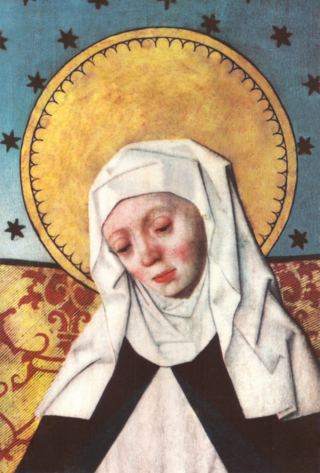
Bridget of Sweden, OSsS, born Birgitta Birgersdotter and also known as Birgitta of Vadstena, was a Swedish Catholic mystic and the founder of the Bridgettines. Outside Sweden, she was also known as the Princess of Nericia and was the mother of Catherine of Vadstena.

Filippo Lippi, also known as Lippo Lippi, was an Italian Renaissance painter of the Quattrocento and a Carmelite priest. He was an early Renaissance master of a painting workshop, who taught many painters. Sandro Botticelli and Francesco di Pesello were among his most distinguished pupils. His son, Filippino Lippi, also studied under him and assisted in some late works.

The Wilton Diptych is a small portable diptych of two hinged panels, painted on both sides, now in the National Gallery, London. It is an extremely rare survival of a late medieval religious panel painting from England. The diptych was painted for King Richard II of England, who is depicted kneeling before the Virgin and Child in what is known as a donor portrait. He is presented to them by the English saints King Edmund the Martyr, King Edward the Confessor and patron saint, John the Baptist. The painting is an outstanding example of the International Gothic style, and the nationality of the unknown artist is probably French or English.
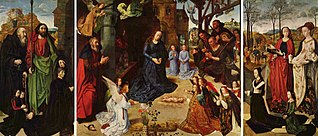
The Portinari Altarpiece or Portinari Triptych is an oil-on-wood triptych painting by the Flemish painter Hugo van der Goes, commissioned by Tommaso Portinari, representing the Adoration of the Shepherds. It measures 253 x 304 cm, and is now in the Galleria degli Uffizi in Florence, Italy. This altarpiece is filled with figures and religious symbols. Of all the late-fifteenth-century Flemish artworks, this painting is said to be the most studied.

The Mystical Nativity is a painting in oil on canvas executed c. 1500–1501 by the Italian Renaissance master Sandro Botticelli, in the National Gallery in London. It is his only signed work and has an unusual iconography for a painting of the Nativity.

The Nativity of Jesus has been a major subject of Christian art since the 4th century.

The Life of the Virgin, showing narrative scenes from the life of Mary, the mother of Jesus, is a common subject for pictorial cycles in Christian art, often complementing, or forming part of, a cycle on the Life of Christ. In both cases the number of scenes shown varies greatly with the space available. Works may be in any medium: frescoed church walls and series of old master prints have many of the fullest cycles, but panel painting, stained glass, illuminated manuscripts, tapestries, stone sculptures and ivory carvings have many examples.

The Melun Diptych is a two-panel oil painting by the French court painter Jean Fouquet created around 1452. The name of this diptych came from its original home in the Collegiate Church of Notre-Dame in Melun. The left panel depicts Étienne Chevalier with his patron saint St. Stephen and the right panel depicts the Virgin and Christ Child surrounded by cherubim. Each wooden panel measures about 93 by 85 centimeters and the two would have been hinged together at the center.

The Nativity at Night or Night Nativity is an Early Netherlandish painting of about 1490 by Geertgen tot Sint Jans in the National Gallery, London. It is a panel painting in oil on oak, measuring 34 × 25.3 cm., though it has been cut down in size on all four sides. The painting shows the Nativity of Jesus, attended by angels, and with the Annunciation to the shepherds on the hillside behind seen through the window in the centre of the painting. It is a small painting presumably made for private devotional use, and Geertgen's version, with significant changes, of a lost work by Hugo van der Goes of about 1470.

The Albani Torlonia Altarpiece is a painting by the Italian Renaissance painter Pietro Perugino, executed in 1491 and housed in the Torlonia Collection, Rome. It was commissioned by Cardinal Giuliano della Rovere, the future pope Julius II.
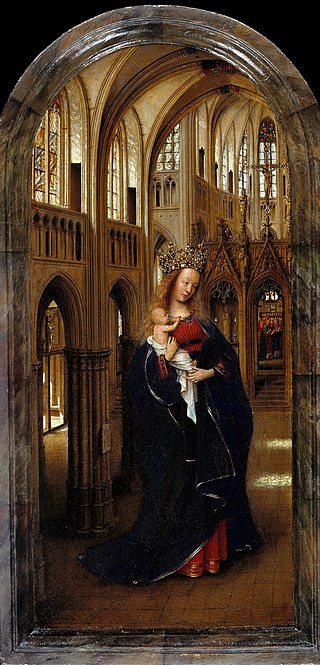
Madonna in the Church is a small oil panel by the early Netherlandish painter Jan van Eyck. Probably executed between c. 1438–1440, it depicts the Virgin Mary holding the Child Jesus in a Gothic cathedral. Mary is presented as Queen of Heaven wearing a jewel-studded crown, cradling a playful child Christ who gazes at her and grips the neckline of her red dress in a manner that recalls the 13th-century Byzantine tradition of the Eleusa icon. Tracery in the arch at the rear of the nave contains wooden carvings depicting episodes from Mary's life, while a faux bois sculpture in a niche shows her holding the child in a similar pose. Erwin Panofsky sees the painting composed as if the main figures in the panel are intended to be the sculptures come to life. In a doorway to the right, two angels sing psalms from a hymn book. Like other Byzantine depictions of the Madonna, van Eyck depicts a monumental Mary, unrealistically large compared to her surroundings. The panel contains closely observed beams of light flooding through the cathedral's windows. It illuminates the interior before culminating in two pools on the floor. The light has symbolic significance, alluding simultaneously to Mary's virginal purity and God's ethereal presence.
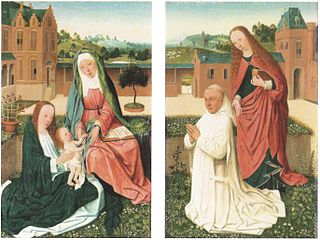
The Master of the Brunswick Diptych was a Dutch early Renaissance painter.
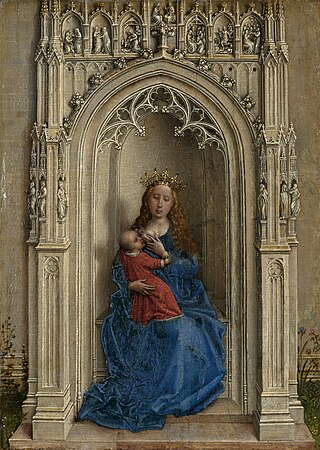
The Virgin and Child Enthroned is a small oil-on-oak panel painting dated c. 1433, usually attributed to the Early Netherlandish artist Rogier van der Weyden. It is closely related to his Madonna Standing, completed during the same period. The panel is filled with Christian iconography, including representations of prophets, the Annunciation, Christ's infancy and resurrection, and Mary's Coronation. It is generally accepted as the earliest extant work by van der Weyden, one of three works attributed to him of the Virgin and Child enclosed in a niche on an exterior wall of a Gothic church. The panel is housed in the Museo Thyssen-Bornemisza in Madrid.
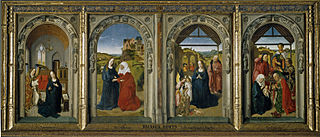
The Triptych with Scenes from the Life of the Virgin is an oil painting on panel by the Early Netherlandish painter Dieric Bouts. It was executed c. 1445 and is now in the Museo del Prado, in Madrid.

The Bladelin Altarpiece, or Middelburg Altarpiece, is a triptych painting created around 1450 by the Early Netherlandish painter Rogier van der Weyden, towards the end of his artistic career. It depicts scenes relating to the birth of Jesus; and as the only nativity scene definitively attributed to van der Weyden is sometimes known as the Nativity Triptych.

Two small paintings in London and New York are believed to come from the same predella, and are attributed to Zanobi Strozzi, a Florentine painter who was probably a pupil of Fra Angelico. They are an Adoration of the Magi in the National Gallery in London, and a Nativity in the Metropolitan Museum of Art in New York. They date to about 1433–34 and are in tempera and gold on panel.

The Adoration of the Shepherds is a c. 1515–1520 oil on panel painting of the Nativity by the German artist Lucas Cranach the Elder in the collection of the Gemäldegalerie Alte Meister in Dresden.
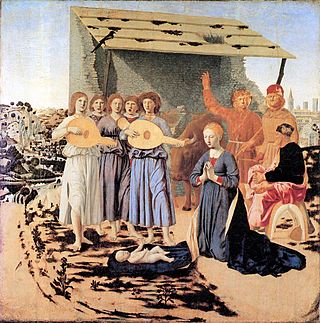
The Nativity is an oil painting by Italian Renaissance artist Piero della Francesca, dated to 1470–75. The painting depicts a scene from the birth of Jesus, and is one of the latest surviving paintings made by the artist before his death in 1492. Held by the National Gallery in London, it measures 124.4 cm × 122.6 cm. It is a popular image on Christmas cards.

The Adoration of the Shepherds is a circa 1480 oil on panel by the Colmar painter-engraver Martin Schongauer in the collection of the Gemäldegalerie, Berlin.





















